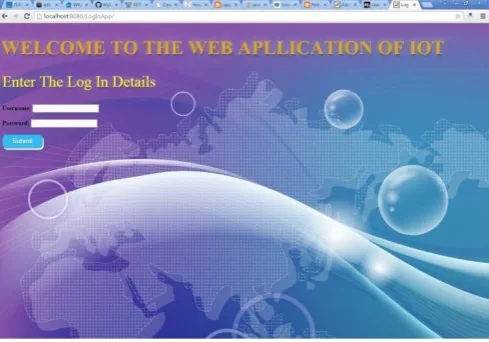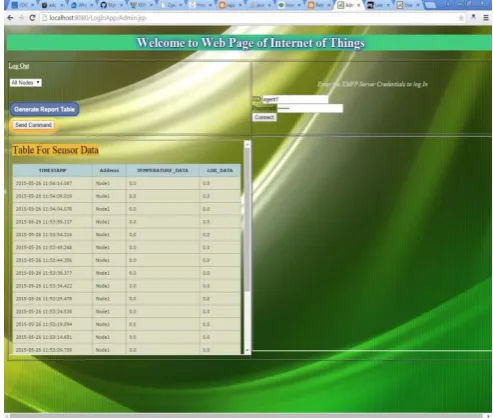Design of Gateway for Integration of Wireless
Sensor Network to Internet
Jaywant Kamble, Prof. Mahesh Navale
PG Student [VLSI], Dept. of E&TC, SKNCOE, Pune, Maharashtra, India Assistant Professor, Dept. of E&TC, SKNCOE, Pune, Maharashtra, India
ABSTRACT:According to analyst and media, in 2008, the number of connected devices surpassed connected people and it has been estimated that by 2020 there will be 50 billion connected devices which is seven times the world population. In fact, one of the most important elements in the IoT paradigm is wireless sensor network (WSN). WSN behave as a digital skin, providing a virtual layer where the information about the physical world can be accessed by any computational system. In the Internet of Things (IoT), the everyday objects that surround us will become proactive actors of the Internet, generating and consuming information. By embedding computational capabilities in all kinds of objects and living beings, it will be possible to provide a qualitative and quantitative leap in several sectors: healthcare, logistics, domestics, entertainment and so on. There are so many approaches for putting sensor data to Internet, in this project the Gateway approach is used. Gateway will act as a translator between WSN network and the Internet network. Gateway will capture or accept sensor data and with by doing necessary operations on the data will put that data on the Internet. With Gateway approach, the load on the sensor node is reduced significantly and hence the cost and battery power to establish the sensor network and to get sensor data and make it available on the Internet for further use in web application.
KEYWORDS:WSN, Internet of Things, Gateway, Zigbee.
I.INTRODUCTION
In the upcoming Internet of Things (IoT), the everyday objects that surround us will become proactive actors of the Internet, generating and consuming information. The elements of the IoT comprise not only those devices that are already deeply rooted in the technological world (such as cars or fridges), but also objects foreign to this environment (garments or perishable food), or even living beings (plantations, woods or livestock). By embedding computational capabilities in all kinds of objects and living beings, it will be possible to provide a qualitative and quantitative leap in several sectors: healthcare, logistics, domestics, entertainment, and so on[1].
At larger level if we look towards it, it’s basically three layer architecture Context aware layer, Network layer and application layer that make the IoT architecture [2]. This paper is implementation paper and the paper is arranged as, Section II gives the brief about the technologies used to implement the IoT, Section III gives the details about the proposed methodology for the project, Section IV gives the results of implementation and Section V concludes the paper and gives the guideline regarding the future work that can be done in this project.
II.LITERATURE SURVEY
IoT is a hot topic in which many important players in connectivity predict a large growth within the next ten years. But till date there no any promising standard protocols and architecture is designed for IoT, that’s why key players who are already towards implementation taking the suitable protocols and started the implementation of the IoT system for particular interest application.
As given in [2], the generalised architecture consists of three layer architecture which contains: Context aware layer, Network Layer, Application Layer.
There are many different wireless technologies in the IoT atmosphere [3] as follows: 1. Zigbee
ISSN (Print) : 2320 – 3765 ISSN (Online): 2278 – 8875
I
nternational
J
ournal of
A
dvanced
R
esearch in
E
lectrical,
E
lectronics and
I
nstrumentation
E
ngineering
(An ISO 3297: 2007 Certified Organization)
Vol. 4, Issue 6, June 2015
This three are mostly used and from the comparison given in Table 1, we can observe that application is the key point for the selection of the protocol.
Parameter Zigbee Bluetooth low Energy
WLAN
Cost Low Low High
Security Moderate Moderate High Power
Consumption
Very Low Moderate High
Range Less than
100m
Less than 100m
More than 100m
Nodes 1024 to
65532
7 or more Depends on router
Data Rate Low Moderate High
Table 1: Comparison of Wireless Protocols
Protocols Available to be used in IoT Architecture are as given below:
1. Web Technologies: CoAP(Constrained Application Protocol),DTLS (Datagram Transport Layer), DDS (Data-Distribution Service for Real-Time Systems), DPWS(Device profile based Web Services): WS-Discovery, SOAP, WS Addressing, WDSL, and XML Schema, HTTP/REST, MQTT(Message Queuing Telemetry Transport), UPnP, XMPP(Extensible Messaging and Presence Protocol), AMQP (Advanced Message Queuing Protocol), etc.
2. MAC/PHY Technologies: Zigbee, WiFi, WiMAX, Bluetooth, Digi Mesh,NFC.
Organizations in IoT are as belows:
1. ETSI (European Telecommunications Standards Institute) 2. IETF (Internet Engineering Task Force)
3. IEEE (Institute of Electrical and Electronics Engineers) 4. OMG (Object Management Group)
5. OASIS (Organization for the Advancement of Structured Information Standards) 6. OGC (Open Geospatial Consortium)
III.PROPOSED METHODOLOGY
As given till now the IoT is the very large paradigm, consisting of every technology till now evolved. It has so many different standards used for real time deployment which makes it difficult to be established as explained in literature survey section.
In this project we will use the gateway approach because of so many advantages of using it as listed below: i. Reduced work load on the nodes in the IoT.
ii. Reduced power consumption of nodes which makes them stay on the field for more time. iii. Reduced maintenance cost due to increased life time of network.
iv. Strong functionalities can be provided to the network as the gateway is more intelligent and resides at the field area.
Fig.1: Proposed Methodology
The actual implementation of the proposed methodology can be given as Fig. 2., In this raspberry pi is used as a Gateway and Xbee is used to establish the WSN network and Web Application forms the user Interface.
Fig. 2 : Implementation of the proposed Methodology
IV. RESULTS AND DISCUSSION
The results of the projects can be divided into two parts 1. Database logged data
ISSN (Print) : 2320 – 3765 ISSN (Online): 2278 – 8875
I
nternational
J
ournal of
A
dvanced
R
esearch in
E
lectrical,
E
lectronics and
I
nstrumentation
E
ngineering
(An ISO 3297: 2007 Certified Organization)
Vol. 4, Issue 6, June 2015
Fig. 3 shows that the data gets successfully logged into the database and can then be used for applications which will use this data and perform the functions of interest.
H2 database is the very light weight and used in many applications where the database data storing and getting requires a lot of speed or more specifically we can say that the Real Time applications uses H2 database.
Fig. 4: User Log In Page of Web Application
“Login Page” of the Web Application performs the functions of the User validation and verification and then depending on the user type displays User Page or Admin Page.
In this project two types of the users are considered 1. General Users/ General Public
2. Administrative access user
As per the user the controls or functions given are different as shown in Fig. 5 and Fig. 6.
Fig. 5: User Page of Web Application
Fig. 6: Admin Page of Web Application with more functions
Admin Page is for the Administrative user and hence the more functionality are given such as command button which is used to send the command to the WSN network output device, for prototyping it the LED is used which gets ON for 3 seconds and then gets OFF. This command button functionality is to show the ability to control the WSN node output from the Web Application.
V. CONCLUSION
In this project, literature survey about the different IoT system components is carried out. From this the most suitable Zigbee protocol is selected and implemented successfully for the WSN network and Raspberry Pi is used as the hardware for the Gateway as per its more promising feature as per IoT is considered and JAVA is used to develop the application which will run on the Raspberry Pi and make it function as a Gateway. Web Application makes the user interface more attractive. As it is the first step towards the learning and implementing the recent and hot technology or more specific paradigm called as Internet of Things (IoT) there are so many work can be done in it such as protocol standardisation for IoT and implementing more functionalities so that it can cover broader applications.
ACKNOWLEDGEMENT
I am also very much thankful to my guide Prof.Mahesh Navale and Dr. S. K. Shah, HOD PG Department, SKNCOE, Pune for their continuous valuable guidance and support. This project is sponsored and supported by “Avaya India PVT LTD”. I am thankful to my Manager for giving me the opportunity to work in such a latest technology and for valuable guidance and support throughout. I am also thankful to my parents for moral support during the process.
REFERENCES
[1] Rajeev Piyare and Seong Ro Lee2, “Towards Internet of Things (IoT): integration of wireless sensor network to cloud services for data collection and sharing”, International Journal of Computer Networks & Communications (IJCNC) Vol.5, No.5, September 2013.
[2] Jaywant Kamble, Prof. Mahesh Navale, “ TOWARDS IOT: INTEGRATION OF WIRELESS SENSOR NETWORK TO INTERNET WITH GATEWAY APPROACH”, IJPRET, 2015; Volume 3 (9): 535-545, 01/05/2015.
[3] Aishwarya.V, Felix Enigo V.S., “IP based Wireless Sensor Networks with Web Interface”, IEEE-International Conference on Recent Trends in Information Technology, ICRTIT 2011.
[4] Mats Andersson, “Short-Range Low Power Wireless Devices and Internet of Things (IoT)”, Contributed By Digi-Key Corporation 2014-01-16.
ISSN (Print) : 2320 – 3765 ISSN (Online): 2278 – 8875
I
nternational
J
ournal of
A
dvanced
R
esearch in
E
lectrical,
E
lectronics and
I
nstrumentation
E
ngineering
(An ISO 3297: 2007 Certified Organization)
Vol. 4, Issue 6, June 2015
[6] Ravi TejaGuthikonda, Sai SrikarChitta, Shraddha Tekawade, TriptiAttavar,“COMPARATIVE ANALYSIS OF IoT ARCHITECTURES”, TLEN 5710 Capstone April 25, 2014.
[7] PrajaktaPande, AnandPadwalkar, “Internet of Things-Future of Internet: A Survey”, International Journal of Advance Research in Computer Science and Management Studies, Volume 2, Issue 2, February 2014.
[8] Vasileios Karagiannis1, Periklis Chatzimisios1, Francisco Vazquez-Gallego2, Jesus Alonso-Zarate2,” A Survey on Application Layer Protocols for the Internet of Things”, Transaction on IoT and Cloud Computing 2015.



